#Penny Black postage stamp
Explore tagged Tumblr posts
Text
Victorian Christmas Cards
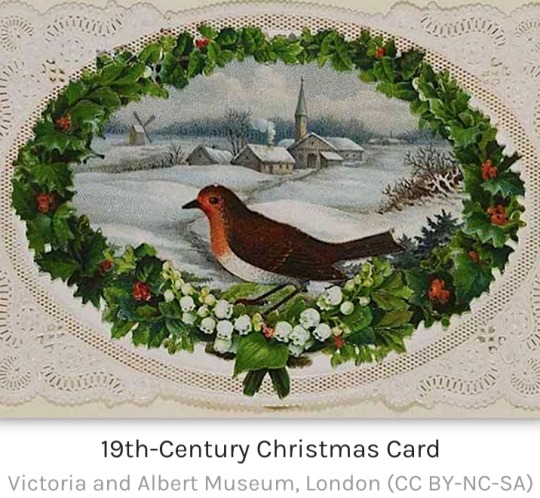
Printed Christmas cards became popular in the Victorian period (1837-1901), thanks to a combination of cheaper printing techniques and even cheaper post, with the arrival of the Penny Black postage stamp.
Coming in all shapes, sizes and materials, Christmas cards were sent in their millions to all corners of the British Empire.
Victorian illustrators created an entire mythology of exactly what we imagine a European Christmas should look like with their now-classic scenes of present-covered Christmas trees, holly, robins, sleighs, and snow-covered country lanes.
When we dream of a white Christmas, it is the festive cards of the 19th century, which are largely responsible for that evergreen imagery.
Origins

Adults have, of course, been writing letters to each other for centuries.
Even before there was an official public post system, letters were delivered in person, by servants, and via transport coaches.
There had also been prints made from the 15th century, using woodcuts or copperplate printing techniques, especially for calendars.
It was in the Victorian period that several factors conspired to make printed Christmas cards the hugely popular phenomenon they became.
The historians Antony and Peter Miall suggest in The Victorian Christmas Book that the origins of cards for the festive season lie in the classroom.
From the 18th century, schoolmasters had their pupils work on a 'Christmas Piece' in the month of December.
This work involved pupils selecting a sheet of fine paper and producing a sample of their writing, principally to show off to their parents evidence of their academic progress that year.
The paper often came with a decorated engraved border, and by the 19th century, it was popular for the pupils to draw their own decorative borders using coloured ink.
"These offerings were the forerunners of the great Victorian Christmas Card" (Miall, 37).
Other sources of inspiration for the decorative Christmas card may have been printed music sheets with decorative borders and covers, engravings commissioned to mark important anniversaries, school reward cards for hard-working pupils, fine illustrated notepaper, and the more ornate varieties of visiting cards, which were left when one called upon someone and they were not at home.
The First Christmas Card

Sir Henry Cole (1808-1882) was a civil servant who had, in 1840, reformed the British postal system by helping to create the Universal Penny Post where senders used the now-famous Penny Black postage stamps.
Cole would later become the first director of the Victoria and Albert Museum in London.
In 1843, Cole had a brilliant idea.
Not only could he save himself writing different individualised letters to his friends and family at Christmas, but he could also brighten the season with a colourful card printed for the express purpose of sending his compliments of the season.
Accordingly, Cole commissioned John Callcott Horsley (1817-1903), an artist and illustrator who was a member of the Royal Academy, to produce the first printed Christmas card.
THE FIRST CARDS WENT ON SALE TO THE PUBLIC AT THE RATHER HIGH PRICE OF ONE SHILLING PER CARD.
Horsley's design for the card, which was about the size of an ordinary visiting card (2 x 3 inches or 5 x 7.5 cm), showed different generations of the Horsley family raising a toast – presumably to the absent friend who is the recipient of the card – while flanked with scenes showing acts of charity, then, as now, an important element of the Christmas season.
On the left are people giving food to the needy, and on the right, they give clothing.
There was a border of a wood frame intertwined with ivy, and below the main image, a greeting of "A Merry Christmas and a Happy New Year to You."
There was a space along the very top and bottom of the card left blank to write a short handwritten and personalised message to the receiver.
One thousand such cards were printed and then hand-coloured. The cards went on sale to the public at the rather high price of one shilling per card.
Perhaps unsurprisingly for a new and relatively expensive idea, there were few buyers.
The Idea Catches On

Fortunately for the future of Christmas cards, the royal family was enthusiastic for all things Christmassy.
In particular, Prince Albert (1819-1861) brought German Christmas traditions to England such as the Christmas tree.
It was the younger members of the royal family who adopted the idea of sending each other handmade greeting cards both at Christmas and New Year.
Queen Victoria must have approved since she later started the trend of public figures sending 'official' Christmas cards showing more often than not themselves and their family in a festive setting.
Then, in 1844, there was another attempt at the commercial Christmas card, and this was much more successful.
Mr W. C. T. Dobson sold a printed card, which carried an illustration of the "Spirit of Christmas."
In 1848, a card printed by William Maw Edgley (1826-1916) repeated the theme of Cole's card but added scenes of general merriment and holly to the imagery.
Printers now knew they were onto a good thing. They became more and more ambitious with the designs of their cards, which were available to buy in stationers and bookshops.
From 1879, rather than pricey single cards, people could buy cheap packs of cards from tobacconists and toy shops, often imported from Germany.
This development went hand-in-hand with the new half-penny post for postcards, and so now people of all classes could send Christmas cards to their loved ones.
Victorian Christmas Card Designs

The first cards were printed on small single sheets of card, but they soon progressed to come in all shapes and sizes.
Victorian Christmas cards were typically lithographed and hand-coloured before colour-printing took over.
Many used embossed paper, sometimes with cut-out parts to resemble lace, particularly for borders.
There were even cards decorated with ribbons, tassels, real lace, tinsel, and coloured glass.
Satin, silk and brocade were also popular materials to enhance the feel of the card.
The most exotic of cards were scented, had padded additions, and incorporated pressed flowers.
One card for sale boasted it was made of no fewer than 750 separate pieces.
If one creation reflected the Victorian love of accumulating individual beautiful materials to create an even more beautiful finished article, it was the Christmas card.
With so many possible materials being used in a single card, it is no wonder that draper's shops included them in their Christmas stock.
VICTORIAN ILLUSTRATORS WERE LARGELY RESPONSIBLE FOR WHAT WE TODAY IMAGINE AS A CLASSIC 'CHRISTMAS SCENE'.
There was a great variety in the shape of cards, too, with the most popular ranging from the classic rectangular form to oval, circular, diamond, crescent, and bell-shaped cards.
Some cards were folded, others made into fan shapes, or they reflected the object they illustrated such as a post box or purse.
Cards might include moving parts or flaps that could be opened to reveal an additional scene or message.
Some had tabs that, when pulled, moved the legs and arms of a character on the front of the card or they had a disk that could be turned to show different scenes in a central window.
There were all kinds of subjects depicted on cards, many of which included humorous cartoons and everyday life, sometimes not at all related to Christmas.
Religious themes remained popular such as angels and scenes from the Nativity, but there was a definite shift away from these to more secular subjects as the Victorian era progressed.
Victorian illustrators were not without humour or fear of the risqué, nor did they miss the opportunity to trick the viewer with many cards showing two scenes depending on which direction the card was held.

Victorian illustrators were largely responsible for what we today imagine as a classic 'Christmas scene':
old churches and country lanes in the snow, sleigh rides, plump robins, glistening holly and mistletoe, and presents on or under the Christmas tree.
The popular snow scenes on Victorian Christmas cards reflected the string of harsh winters in England through the 1830s and 1840s.
White Christmases became much rarer thereafter, but the scene in people's imaginations was by then set.
In the same way, the Christmas food we imagine being eaten by Dickensian characters in the 19th century is, like in the cards, always golden roast turkeys and great steaming Christmas puddings the size of cannon balls.
Father Christmas was a popular figure on cards, but he evolved over the decades.
His appearance morphing from a Falstaffian character to a jolly old man with blue trousers and a crown of holly, and finally on to his definitive red suit with white fur trim.
Father Christmas' mode of transport also evolved to keep up with the times.
The Victorian Father Christmas used any means he could to reach people's chimneys, such as the popular bicycle of the 1880s, the new motor car of the 1890s, the ever-growing modern railway network, or even a hot air balloon.
Christmas cards had become such a staple part of the season that they now attracted the top artists to illustrate them, names like Linnie Watts, who produced a series of cards showing children, and Harry Payne, who drew soldiers, a poignant theme for those with loved ones serving far from home in the armed forces of the British Empire.
Cards changed over time as tastes changed.
For example, black backgrounds to make the main picture more striking were popular in the 1870s.
Cards reflected modern trends in art, too.
By the end of the century, art nouveau designs were appearing, with highly decorative designs and subjects inspired by the works of such fashionable artists as Alphonse Mucha (1860-1939).
With cards being sent around the world, the tradition quickly took root in other countries, notably in the United States from 1874, with the cards printed by Louis Prang (1824-1909), popularly known as the "Father of American Christmas Cards."
Collecting Christmas Cards

Beautifully made and capturing memories of the season, the Victorian middle classes became avid collectors of Christmas cards, which explains why it became common to have the year printed somewhere on the card.
Perhaps the most famous card collector was George Buday.
He even wrote a celebrated book on the history of Christmas cards, his The Story of the Christmas Card.
He donated his collection of over 3,000 cards to the Victoria and Albert Museum.
This museum today has over 15,000 Christmas cards in its archives and each Christmas, it reprints old Victorian designs so that they can, once more, just as in days of yore, carry people's Christmas wishes far and wide.
#Victorian Christmas Cards#Christmas Cards#Christmas#Victorian period#Victorian era#Penny Black postage stamp#Victorian illustrators#European Christmas#White Christmas#19th century#1800s#Sir Henry Cole#British postal system#Universal Penny Post#John Callcott Horsley#Queen Victoria#Prince Albert#Mr W. C. T. Dobson#William Maw Edgley#Father Christmas#Linnie Watts#Harry Payne#Alphonse Mucha#Louis Prang#George Buday#Victoria and Albert Museum
0 notes
Photo
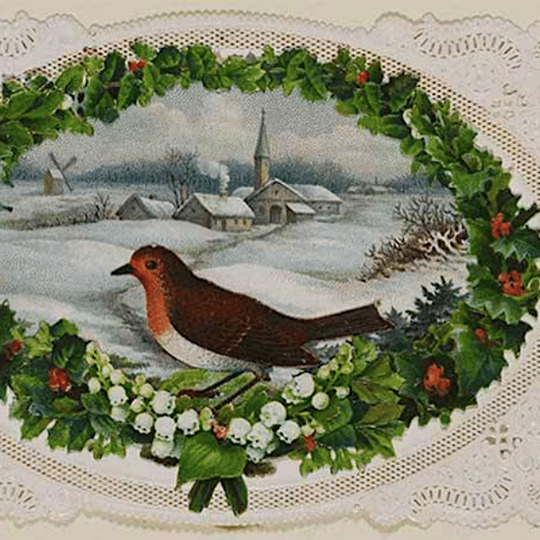
Victorian Christmas Cards
Printed Christmas cards became popular in the Victorian period (1837-1901) thanks to a combination of cheaper printing techniques and even cheaper post, with the arrival of the Penny Black postage stamp. Coming in all shapes, sizes, and materials, Christmas cards were sent in their millions to all corners of the British Empire. Victorian illustrators created an entire mythology of exactly what we imagine a European Christmas should look like with their now-classic scenes of present-covered Christmas trees, holly, robins, sleighs, and snow-covered country lanes. When we dream of a white Christmas, it is the festive cards of the 19th century which are largely responsible for that evergreen imagery.
Continue reading...
46 notes
·
View notes
Text



February 2nd 1782 saw the birth of James Chalmers in Arbroath - he devised the adhesive postage stamp.
Oh I hear you say I thought that it was that guy Rowland Hill and his Penny Black, nope it was a Scotsman, from the mid 1820s he began to campaign for improvements to the speed of the postal service between Edinburgh and London, eventually succeeding in reducing the time letters took by a day in each direction.
At the time the postal service was fragmented and chaotic, and Chalmers was one of a number of people seeking to bring about improvements. Two key problems revolved around the charges made for post, which varied in a highly complex way depending on the distance the item of mail was due to travel, and finding a means of showing that postage had been paid on mail.
From 1834, James Chalmers was promoting the idea of an adhesive stamp which could then be cancelled when used. Change only came, however, following the publication of a pamphlet Post Office Reform: its Importance and Practicability by Rowland Hill in 1837. In it he proposed a single rate of postage, tied to the use of adhesive stamps.
The result was the penny post, introduced in 1840 alongside the world's first adhesive postage stamp, the Penny Black. Rowland Hill went on to achieve great acclaim, considerable wealth and a knighthood. James Chalmers, in contrast, died in relative obscurity in 1853 and was buried in the Howff, a burial ground in the centre of Dundee.
Pics are of Chalmers, a plaque at Castle Street Dundee, where he had his bookshop, and his grave at The Howff Cemetery in the city.
Loads more about the man here https://archive.ninetradesofdundee.co.uk/?wpfb_dl=3883
20 notes
·
View notes
Text
Box of lies
"A present is on it’s way, keep your eyes peeled closely."
Just like Taylor is affectionately known as Tayliar, she has shown us time and again that she is the unreliable narrator. To give us a chance to see the love story hidden between the lines she has left a trail of breadcrumbs in obscure places like this series of skits, but you might just find that the use of mascots, symbolism and references to Taylor’s music foreshadowed more than just her muse…

The items in the box of lies game featured on the tonight show starring Jimmy Fallon are full of hidden references to Taylor's love story. Just like a game of ping pong, this skit is set up so each opponent go back and forth as they attempt to bluff each other by describing what's in their box. This typically starts with the guest picking a box from the shelf as they take turns, so these are in order unless otherwise stated.
Tina Fey part 1 and 2
Black dress
Part 1
Box 5 -colander full of ping pong balls
Box 3 -long handled fork, telescopic handle
(You scratch my back, I'll scratch yours)
Lied -red Swiss army bartender tools
Part 2
Box 7 -taxidermy squirrel
Lied -Patrick Stewart doll, 6 inches
Box 9 -facial wax strips
Box 1 -hotdog in a ziplock bag
Julia Bowen
Dark gold dress
Box 4 -wavy bowl with a taxidermy tarantula
Box 3 -black card with a tiny rubber chicken
Lied -feather glued to paper
Box 8 -toupee in its package
Lied -replica stripper on a stage

Melissa McCarthy
Black dress, bird necklace
Box 4 -joint in a ziplock bag
Lied -dispenser for Dixie cups
Box 6 -ransom style note written with magazine letters
“mElisSa mcCartTy is aWesomE!”
Lied -Fort Lauderdale magnet
Box 7 -Jane Fonda workout VHS in a large focaccia sandwich
Jenifer Lawrence
Dark blue dress
Box 9 -Rubik's cube inside jelly
Box 3 -Full house Jesse barbie doll box and doll, Hershey kisses
Lied -back street boys action figure
Box 4 -egg roll burrito in a birds nest
Lied -mini horse, flinstone vitamins
Kate Hudson part 1 and 2
Black dress, white details
Part 1
Box 7 -bowl of pennies and a spoon
Box 6 -orange burger and fries, American flag pick
Lied- tiny slot machine, three Harry Styles heads as jackpot
Part 2
Box 4 -plate of yellow jello, turtle
“What’s like a turtle, but not a turtle?”
(part 1 = hare and part 2 = tortoise)

Kerry Washington
Blue and white half dress
Box 4 -pumpkin full of spaghetti
Box 3 -necklace with troll dolls
Lied -iPhone 6+, figurine, Justin Bieber tattoo
Emma Stone
Black and white shirt and skirt
Box 4 -tray with a ‘frozen poster’ frozen in an ice block
Lied -3-4 instruction cards from a deck of cards that you throw out before you play the game, stacked in the shape of a salamander 🦎
Box 5 -faux plastic hand with watch
Lied -plate with a tiny squirrel surfing on lettuce

Channing Tatum
“First male guest ever to play this game”
Box 3 -jello on a blue plate with a Chewbacca action figure inside
Lied -bowl of chilli frozen in gelatine
Box 2 -hot water bottle wrapped in sports bandage
Lied -sugar cube, teabag thread, sticker that says “lick me or legalise it”
Box 4 -baby ET swaddled in pink crown patterned sleeping bag
Nicole Kidman
Black striped dress
Box 4 -fed ex book with a piece of pizza stuck on front
Lied -old cheese sandwich with bite taken out
Box 2 -hammer covered in postage stamps
Lied -3 pound statue
Box 8 -box of matches and red matchbox car
Lied -condom

Scarlett Johansson
White dress
Box 4 -Scarlett and Gumby on a park bench
Lied -hotdog bun shaped like the hulk
Box 5 -mannequin head, goggles filled with balls
Box 3 -“people love this number!”
Starbucks iced coffee filled with baked beans

Heidi Klum
Black dress
Box 3 -fireball whiskey minis in a pink claw bath
Lied -butterfly shadow box with chewed gum (lego house reference?)
“That’s cinnamon whiskey” (both take a shot)
“You’re my best friend!” -Jimmy
Box 8 -slinky full of Monopoly money, $1 on front
Lied -jello mould, Justin Bieber doll head
Box 7 -grass, rubber red lips
Lied -burrito, started over and told the truth

Julianne Moore
White dress suit
Box 1 -(meek voice) Oscar the grouch, MAGA hat
Box 9 -naked Ken doll wearing roller skates
Lied -book, Jimmy, macaroni, abc
“You should give me the Oscar”
Box 5 -“it’s like a zeitgeist thing” (talking about box 5)
Friends forever photo frame of Julianne and Jimmy
Lied -silver paddle brush, knitted sock cozy

Adele
Black dress, red details
Box 2 -t-rex in cowboy outfit
Lied -t-Rex dressed as a fairy
Box 5 -Simon button game, 💚❤️💙💛 wheel, four noses attached to each one, 💙 is 🤥 (Tayliar)
Lied -GI Joe dressed as Santa, candy cane Chinese throwing star
Box 9 -giraffe, 3 doughnuts as a necklace

Vince Vaughn
Box 9 -Hulk in a bowl of crayons
Box 8 -jelly bean taco
“You like Jim Carrey?”
Lied -ruler made out of a celery stick
Russell Crowe
Box 7 -toy xylophone, Australian dogs (pairs)
Box 3 -junk drawer
“Empty roll of scotch tape”
Box 5 -starfish, plastic hands on tips
(Jimmy highlights his pinky ring)
Lena Dunham
Black dress, diamond shaped earrings
Box 4 -Leo DiCaprio leaflets that say 'Frances McDormand'
Lied -Banana, sideshow bob hair, raisin nose
Box 9 -chariot helmet full of rubber duckies
Lied -Barbie hot tub, 3 Brady bunch kids
Box 1 -red Grimm’s fairytales book with tree trunks on the cover
Pull tab to reveal a Tennessee whiskey bottle

Matt Damon
Box 4 -Gnome bonsai
Lied -slinky, phallic symbol, pinnochio
Box 3 -glass piggy bank full of shrimp
Lied -hot tub, Luke Skywalker
“Hillary Clinton, Donald Trump and Justin Bieber in a bathtub”
Emily Blunt
Black dress
Box 4 -record player with pizza as the record
Box 3 -a number 3 box within another number 3 box etc
Pretended it was heavy "why would they put that on the top shelf?"
(Russian doll style box of lies boxes)
Box 5 -“you’re acting like you’ve seen this before”
Monster in a clown costume
Lied -my little pony with a syringe stuck in it

Megyn Kelly
Maroon dress
Box 4 -iPhones body, deer head and dinosaur tail
Box 6 -furby with a beer hat
Box 8 -deck of cards with flubber tube through the middle.
Jack of spades as the back card ♠️

Alec Baldwin
Purple shirt
Box 9 -baby gummy bear, dummy, blanket
Box 4 -plastic glove full of olives and wearing a wedding ring
Lied -shavings of pickle, tiny door mat “ermehgerd welcome”
Box 1 -Chewbacca mask, blonde wig
Lied -burrito filled with bananas, Trump joke

Gal Gadot
Gold dress
Box 5 -lucky Chinese cat, cats rule giant hand
Lied -plastic elephant trunk
Box 2 -pineapple, giant ears, purple top
Lied -cabbage patch doll head, cheerio afro
Box 7 -plastic foot, ski slope
Ends with guy doing Wonder Woman dance

Halle Berry
Maroon red dress, Jimmy wearing a pink spotted tie
Box 3 -blank CD tower cake, 1 piece sliced, 5 candles
Lied -elephant, snake wrapped around it
Box 5 -red faced moustache, pencil sharpener machine, pretzel matchsticks to feed it
Box 4 -(put box 3 back in box 4 space on purpose)
“I know a magic trick when I see one. Something just happened”
24 hour dry cleaning shop, characters lined up
“This has got a lot of characters involved”

Margot Robbie
Maroon dress, gold necklaces
Box 4 -“saucy” red lobster
Lied -Jimmy’s head, Jessica rabbit’s body, bobble head “giant”
Box 6 -large hotdog, feet bun, rice, mustard
Lied -ice cream, baseball hat, Trump hair
Box 2 -Egg and nest, face picture of Nicholas Cage
Lied -salad dish, paperweight, bandaids, toy car

Cardi B
Bronze dress
Box 4 -picket fence, grass circle, rolling fluffy balls
Said “Not a peen*” and Jimmy walks away (cat balls)
Box 3 -cowboy pug, Freddy Kruger claw and outfit
(She was pregnant and standoffish)
Chris Pratt
Plaid shirt and suit
“Pick the first box, box, box”
Box 4 -five garden gnomes (dwarfs) in a yoga class
Box 6 -jurassic park, Jello, Geoff Goldblum
Box 5 -spinning ballerina dinosaur
Lied -bedazzled raccoon/fox skull with sharp teeth
John Cena
Blue suit, orange tie
Box 4 -open and twist cosmetic lipstick
“It’s something bejewelled”
Jimmy opened it to reveal a tiny hand
“You shanghaied me!”
Box 3 -praying mantis, bees skipping double Dutch
"Two doubles" "Welcome to my world"
Box 1 -orange head, tap🚰 and blue bandana
Lied -red and black 1970’s Chevy car, the Fonz

Julia Louis-Dreyfus
Black dress, string tied sides, red ring
Box 4 -Stormtrooper, rocking chair, knitting, lamp, cat
Lied -“are you familiar with a closet?”
A horse, huge collection of sandals and heels
Box 3 -table tennis paddle (red side) plugged into a power socket that’s been ripped from the wall
Lied -two contestants from the masked singer, in a tiny hot tub of jello
Box 2 -paint brush, hair with braided ends
"Am I familiar with a closet? Yes." -Jimmy

Chance the Rapper
Blue shirt, khaki pants, red stripe, b+w hat
Box 5 -box of lies set, box for head, head for box
“That is so meta, dude!”
Box 2 -furby, ipod, ostrich egg nest, headphones
Lied -taco shell filled with papa Smurfs
Box 4 -pretended it was empty “antelope grazing” -Jimmy
Pickles strung up like a link of sausages

Emilia Clarke
Black suit, red ring
Box 4 - Coffin, Dracula corn dog, open coffin
Lied -small frog wearing a monocle (mr peanut)
"What should I pick? (Uno!) Uno?"
Box 3 -McDonald’s fries, open burger, hockey puck and sticks
Lied -Donald Trump, lady and the tramp scene
Box 2 -salad bowl full of money, one dollar notes

Blake Lively
Black dress, rings, diamond earrings
“I feel like I’m on the price is right!”
Box 4 -Time turner sand timer, rainbow cereal, milk
Box 3 -the Rock on a rock (alfalfa reference from Blake?)
Lied -brass matte mask, dead pool head on top
Swapped items “I just activated the cereal” -Jimmy
Box 5 -Devin Sawa J14 “pedestal” chilli bird pecker in a park

Kate Beckingsale
White dress, hugged
Box 5 -corndog bouquet, faux pink carnations
“I’ve never touched a corn dog before”
Box 6 -Nintendo console, grilled cheese hunt game
Box 2 -(Jimmy again) mini skateboard, Easter bunny peeps, each holding signs that spell “sup?” (purple, pink, yellow, blue bunnies)
Lied -little dolls, olympic medals, frosted mini wheats, podium
"We have to try American cereals!" -Jimmy

Ana de Armas
Ana de Armas 2 years 🖤
Red wet leather dress "doing this with heels is not good"
Box 5 -pumpkin jacuzzi, three people inside, mix of Star Wars and horror movie characters (Halloween, Jarjar Binks, Friday 13th), holding red nail polish bottle and blue nail polish bottles
Box 3 -Cream lunch box, marriage story poster and rotating scene inside like a ballerina music box
Box 1 -basketball court game, devils vs nuns, orange ball
Lied -turtle, hamburger shell, lives inside the burger
"the turtle lives in the burger"

Taylor Swift
White dress
Box 1 -binoculars, corn, 'I see corn' lanyard (picture to burn)
Lied -Selena Gomez 'wizards of Waverly place' DVD
Box 5 -Chewbacca walking a black beetle in a park, girl on picnic blanket holding a rubber chicken, lady walking a pug on the grass
Lied -family of pinecones playing trouble
"We're the worst poker players. We shouldn't even be allowed outside!"
Box 3 -grey book, biography written by Grimace, picture of his character on the front, 'my life under the golden arches', pull tab with burger and fries inside

Hugh Jackman
And Jimmy Kimmel as the host
Box 3 -barber shop with wolverine character, checkerboard floor
Box 6 -shrimp cocktail birthday cake (Hugh and Ryan reference)

Millie Bobby Brown
Purple outfit, feathery neckline
Box 4 -ET painting, stranger things monster painting with her rainbow makeup palette (IET phone home)
Emphasised ET and Elliot character. “Why mess with the best”
Box 2 -spaghetti and baseballs
Lied -said that it was Elon Musk’s head
Box 5 -baby Yoda, pink outfit, writing on shirt, writing says 'this is the namast-way'
Lied -croc shoe, pasta, watermelon sour patch kid
Box 3 -“lets do it!” baseball hat, pink peptobismal, hot sauce (sriracha)
“I learned from the best!” -Jimmy

Jenna Ortega
Jenna Ortega 1 year ago 🖤
Black dress
Jenna also hosting SNL with 1975. Jimmy said ‘too late’ repeatedly
Box 3 -park scene, cousin it, corgi, trash can, Chewbacca vanity fair magazine
Jimmy dressed as a cowboy in the audience screaming “two!”
Box 5 -Mona Lisa painting, dressed as Woody, cowboy hat, sports flag (similar to Taylor's vintage cat head portraits)
Lied - said that it was colonel sanders from KFC
Box 1 -cowboy hat, racer wheels, Elvis bobble head, marshmallow
Lied -said that it was Peter Pan in a suit and a Leonard Cohen hat

Julia Roberts
Box 5 -Alf on the shelf, peppermint candy
-Peppermint candy picture frame, "Christmas gift to take home?"
(Pretends to smoke and flicks the ash -Matty reference?)
Box 2 -hair dye for the greying grinch, grey and green before and after samples on display "very niche audience"
Lied -bathtub with five barbie dolls, George Santos head
Box 1 -tinned baloney spaghetti, split the points: “first time ever”
Baloney: a lie without caring if it’s true or false

Seth McFarlane
Box 4 -anti hero funeral scene for the cool aid man, 2 apple juice boxes, cool aid man portrait, purple flowers
Lie -Bradley Cooper's nose on a bed of lettuce
Box 2 -heavy, CEO beat magazine, C3PO on cover with tech CEOs
Lied -clothes pin doll, brother and sister, Osmonds scissoring?
"Would broadcast standards on NBC allow that?" -Seth
Box 3 -painting of skunks drinking beer, yellow dunk tank

Demi Moore
Demi Moore 2 weeks 🤍
Pink dress, Questlove wearing pink too
Box 1 -broccoli tree house, angry tomato, ‘no tomatoez allowed’ sign
“Liar, liar, pants on fire” (rotten tomatoes reference?)
Box 5 -class of 1700 yearbook, message to Beethoven from Mozart, Dude!
Lied -yogurt leaflet, small Yoda
Box 3 -Flip phone on the beach, iPhone lounge chair, margarita, cocktail and umbrella, shoes, Mickey Mouse hands

I didn't have enough room to add anymore photos, but feel free to check out the videos for yourself.
"You don't know what you don't know" ✌🏼👩🏼👩🏼🦰
A tortured poet,
Kylie x
3 notes
·
View notes
Text
The Ruby Tuesday restaurant chain was founded in 1972 by Sandy Beall (Samuel E. Beal III…. He’s a third? Interesting) A student at the University of Tennessee, who’s co-investors were fraternity brothers. The first restaurant was located in Knoxville, Tennessee, next to the university campus. It opened on 4/12/1972 The name comes from The Rolling Stones song “Ruby Tuesday”
In 1972 JL was 12 years old.
Billie Jo Armstrong was born on 2/17/1972
Notorious B.I.G was born on 5/21/1972
Eminem was born on 10/17/1972
The Rolling Stones released ‘Ruby Tuesday’ on 1/13/1967 (a Friday) and recorded it in November 1966. Its length is 3:12.
The live version of the song was released on 5/24/1991, and was recorded on 2/27/1990. It was recorded from their live performance at the Korakuen Dome, in Tokyo. Its length is 3:34
The first RT was opened 1916 days after the release of the song. which can also be written as 30 days, 2 months, and 5 years…. 3…2..5? The 325 area code is for a large portion of West-Central Texas including Abilene, San Angelo, Brownwood, Sweetwater, and Snyder. Counties included are Taylor, Tom Green, Brown, Jones, Llano, Scurry, Nolan, Val Verde, Runnels, and Callahan.
Bell, TX is 3 hr and 45 minutes to Sweetwater, TX. It is 231.7 miles 2+1+3=6 6+7=13.
I thought it might be silly to look into that. Nope I don’t think it was. Bell County, TX is part of the following congressional districts: 11th and 31st.
Does this mean the lyric finally makes sense?
“It was the November 31st today
Would've been our anniversary
Two years but you left on the 1st of May
I wrote it on a calendar, was gonna call
But couldn't think of the words to say”
”knew he was a killer the first time that I saw him.” Killeen TX, is 120 miles via bus to Waco. Once again this could be coincidental, but in the worlds we live in coincidences make shit make sense.
Cormac McCarthy’s novel ‘No Country For Old Men’ and its film adaptation take place in West Texas.
NEED TO BREATHE was an opener for Taylor Swift in 2011 for her Speak Now Tour. They have a song called ‘West Texas Wind’
Wouldn’t it be crazy if the RT was the green room, the waiting room where those who are about to audition wait.
In show business, the green room is the space in a theatre, or a similar venue, that functions as a waiting room and lounge for performers before, during, and after a performance or show when they are not engaged on stage. Green rooms typically have seating for the performers, such as upholstered chairs and sofas
Within the context of international organizations such as the World Trade Organization (WTO), the "Green Room meeting" refers to a process in which ambassadors seek consensus informally under the chairmanship of the Director-General. "Green Room meetings often run until the early hours of the morning and can stretch out for days. They can also be tense and dramatic settings in which nerves are taut and tempers evident." The Director-General meeting room at the WTO headquarters Centre William Rappard is called the Green Room since the time the building was occupied by the International Labour Office.
Curtain call: an appearance by a performer (after the final curtain of a play) in response to the applause of the audience.
Curtain Call: The Hits 12/6/2005
And the sequel Curtain Call 2 was released on 8/5/22
224 months apart.
Friday I’m In Love was released on 5/15/1992
The Westing Game was released on 5/1/1978. This is 4126 days after the release of ‘Ruby Tuesday’. 4+1+2+6=13.
The Westing Game was released 2210 days after the first Ruby Tuesday opened. Which can also be broken down to 19 days and 72 months…. 1972 the year that RT opened.
5/1/1776 The Illuminati, is founded in Ingolstadt (Upper Bavaria) by Adam Weishaupt
5/1/1840 The first official adhesive postage stamp, the Penny Black is issued in the UK
1884 - A Proclamation of the demand for an eight hour workday in the United States
1886 - Rallies are held throughout the U.S. demanding an eight hour work day
1898 - The U.S. Navy destroys the Spanish Pacific fleet in the first battle of the Spanish-American War
1915 - The RMS Lusitania is torpedoed off the coast of Ireland and 1,198 lives are lost. This was to be her final crossing of the North Atlantic
1925 - The All-China Federation of Trade Unions is founded
1930 - The planet "Pluto" is named
1931 - The Empire State Building is dedicated in New York City
1950 - Guam is organized as a U.S. Commonwealth
1956 - Jonas Salk's polio vaccine is made available to the public
1961 - Fidel Castro, the Prime Minister of Cuba, proclaims Cuba a socialist nation and abolishes elections
1971 - Amtrak takes over operation of passenger rail service in the U.S.
1989 - The Disney-MGM Studios opens at Walt Disney World near Orlando, Florida
Anna Jarvis, the American founder of Mother’s Day was born on 5/1/1864
Tim McGraw was born on 5/1/1967
J.A.R.V.I.S had his first appearance in The Invincible Iron Man vol. 2 #11 in May 2009. 211 you’re kidding, that's a mirror of 112.
2/11/1942 “Archie” comic book debuts. Well that makes the Betty connection make more sense doesn’t it.
2/11
1752 – Pennsylvania Hospital, the first hospital in the United States, is opened by Benjamin Franklin
1794 – First session of United States Senate open to the public.
1809 - Robert Fulton patents steamboat
1854 - Major streets lit by coal gas for 1st time
1878 - The 1st US bicycle club, Boston Bicycle Club, forms
1916 – Emma Goldman is arrested for lecturing on birth control.
1928 - 2nd Winter Olympic games opens in St Moritz, Switzerland
1936 - Pumping begins to build Treasure Island in San Francisco Bay
1942 - "Archie" comic book debuts
1943 – General Dwight Eisenhower is selected to command the allied armies in Europe, during World War II
1963 - CIA Domestic Operations Division created
1963 - Julia Child's show The French Chef premieres.
1964 - The Beatles play their first US concert at the Washington Coliseum, in Washington, DC. The setlist includes, I Saw Her Standing There, All My Loving, and Twist And Shout.
1971 - US, UK, USSR, others sign Seabed Treaty outlawing nuclear weapons
1973 – Vietnam War: First release of American prisoners of war from Vietnam takes place.
1984 - Wayne Gretzky sets NHL short handed season scoring record at 11
1990 – Nelson Mandela is released from Victor Verster Prison outside Cape Town, South Africa after 27 years as a political prisoner.
1997 – Space Shuttle Discovery is launched on a mission to service the Hubble Space Telescope
2017 - North Korea test fires a ballistic missile across the Sea of Japan
2018 - Saratov Airlines Flight 702 has 71 deaths when it crashes near Moscow, Russia
It would be even crazier if Sandy Beall was actually Stan Lee, who is Stanley Martin Lieber, who just so happened to also be Samuel Westing who was also Sandy McSouthers who is also Julian Eastman. On 4/19/2016 TS did the 73 questions with Vogue interview. She said “get a good lawyer.” Also the lawyer she is talking to that is dressed like a ghost in the antihero video? The man who loved a cameo, who also was a janitor in some of his cameos. Almost like he is the janitor of our reality of High School Never Ends. He made recurring appearances in the Disney XD TV series Ultimate Spider-Man, voicing a high school janitor named Stan, in which he makes references to Lee’s real-life career. Like Tick..Tick Boom.
West (water), south (fire), and east (earth)… no north..no air. Is this in regards to the bird theory? That Big Brother is watching from the sky?
In June of 1972 Stan Lee wrote a plot for a romance story intended to be titled”But One of Us Must Lose!” Ross Andru turned this into a seven page comic. It’s revealed that the guy she loves had been dating her while on a deliberate break from her friend, one intended to make sure he really loved her. So essentially it's the love story of Ross and Rachel, “we were on a break.”
But if Stan is Sam. Then would that make Jonathan be Chuck? Supernatural showed the reality of someone writing the script and it happening according to plan. What if that was a clue in intensely that not only are the shows scripted, “they” were scripted that way. Chuck was God who went rouge with the story but was also in disguise prior to revealing his characters true intentions. He was a struggling author who happened to be a prophet that was writing Sam and Dean’s lives. Everything that happened to them in the books happened to them in reality. Everything Chuck wrote happened. And then he enjoys dicking them around. Well what if a really good author was doing the same thing now. What if this was the industries own secret society to bring down the fuckers that are ruining it for everyone else.
0 notes
Note
Tell us a fun fact about Great Britain!
The first postage stamp was introduced in May 1840. The first stamp was issued in Great Britain and was called “the Penny Black”!
1 note
·
View note
Text
Events 5.6 (before 1940)
1527 – Spanish and German troops sack Rome; many scholars consider this the end of the Renaissance. 1536 – The Siege of Cuzco commences, in which Incan forces attempt to retake the city of Cuzco from the Spanish. 1541 – King Henry VIII orders English-language Bibles be placed in every church. In 1539 the Great Bible would be provided for this purpose. 1542 – Francis Xavier reaches Old Goa, the capital of Portuguese India at the time. 1594 – The Dutch city of Coevorden held by the Spanish, falls to a Dutch and English force. 1659 – English Restoration: A faction of the British Army removes Richard Cromwell as Lord Protector of the Commonwealth and reinstalls the Rump Parliament. 1682 – Louis XIV of France moves his court to the Palace of Versailles. 1757 – Battle of Prague: A Prussian army fights an Austrian army in Prague during the Seven Years' War. 1757 – The end of Konbaung–Hanthawaddy War, and the end of Burmese Civil War (1740–1757). 1757 – English poet Christopher Smart is admitted into St Luke's Hospital for Lunatics in London, beginning his six-year confinement to mental asylums. 1782 – Construction begins on the Grand Palace, the royal residence of the King of Siam in Bangkok, at the command of King Buddha Yodfa Chulaloke. 1801 – Captain Thomas Cochrane in the 14-gun HMS Speedy captures the 32-gun Spanish frigate El Gamo. 1835 – James Gordon Bennett, Sr. publishes the first issue of the New York Herald. 1840 – The Penny Black postage stamp becomes valid for use in the United Kingdom of Great Britain and Ireland. 1857 – The East India Company disbands the 34th Regiment of Bengal Native Infantry whose sepoy Mangal Pandey had earlier revolted against the British in the lead up to the War of Indian Independence. 1861 – American Civil War: Arkansas secedes from the Union. 1863 – American Civil War: The Battle of Chancellorsville ends with the defeat of the Army of the Potomac by the Army of Northern Virginia. 1877 – Chief Crazy Horse of the Oglala Lakota surrenders to United States troops in Nebraska. 1882 – Thomas Henry Burke and Lord Frederick Cavendish are stabbed to death by Fenian assassins in Phoenix Park, Dublin. 1882 – The United States Congress passes the Chinese Exclusion Act. 1889 – The Eiffel Tower is officially opened to the public at the Universal Exposition in Paris. 1901 – The first issue of Gorkhapatra, the oldest still running state-owned Nepali newspaper was published. 1906 – The Russian Constitution of 1906 is adopted (on April 23 by the Julian calendar). 1910 – George V becomes King of Great Britain, Ireland, and many overseas territories, on the death of his father, Edward VII. 1915 – Babe Ruth, then a pitcher for the Boston Red Sox, hits his first major league home run. 1915 – Imperial Trans-Antarctic Expedition: The SY Aurora broke loose from its anchorage during a gale, beginning a 312-day ordeal. 1916 – Twenty-one Lebanese nationalists are executed in Martyrs' Square, Beirut by Djemal Pasha. 1916 – Vietnamese Emperor Duy Tân is captured while calling upon the people to rise up against the French, and is later deposed and exiled to Réunion island. 1933 – The Deutsche Studentenschaft attacked Magnus Hirschfeld's Institut für Sexualwissenschaft, later burning many of its books. 1935 – New Deal: Under the authority of the newly-enacted Federal Emergency Relief Administration, President Franklin D. Roosevelt issues Executive Order 7034 to create the Works Progress Administration. 1937 – Hindenburg disaster: The German zeppelin Hindenburg catches fire and is destroyed within a minute while attempting to dock at Lakehurst, New Jersey. Thirty-six people are killed.
1 note
·
View note
Text
Postage stamps
In 1841, a woman decided she wanted to make decorative paper for her dressing table out of Penny Blacks. People were more than happy to send her their used stamps for free so she could do it. You can imagine how much her decorative paper is worth now!
10 things you might not know about postage stamps:
0 notes
Text
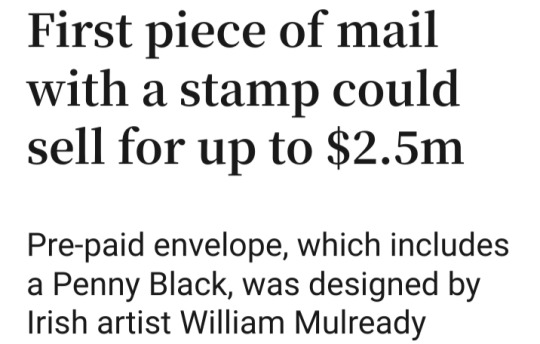

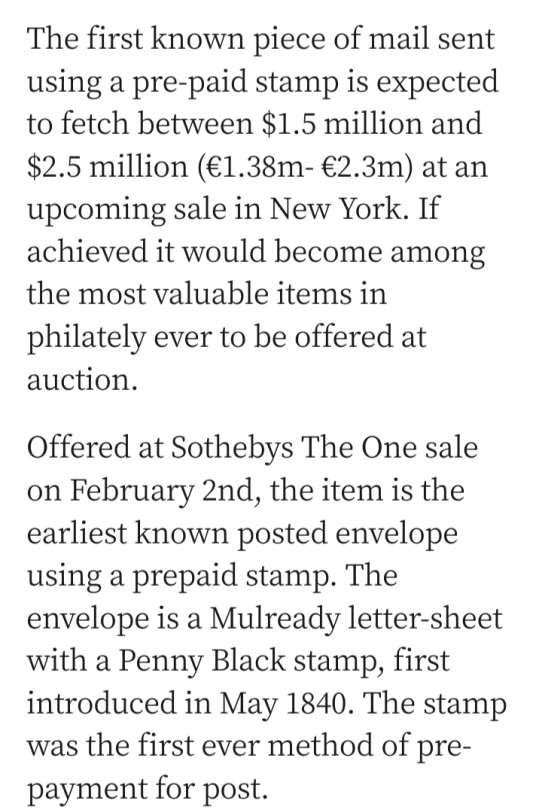
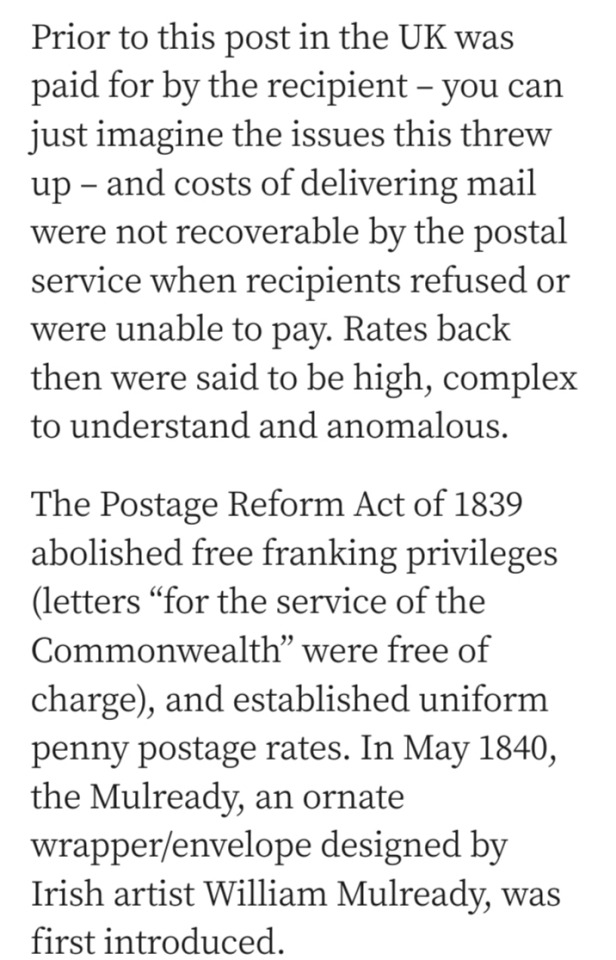

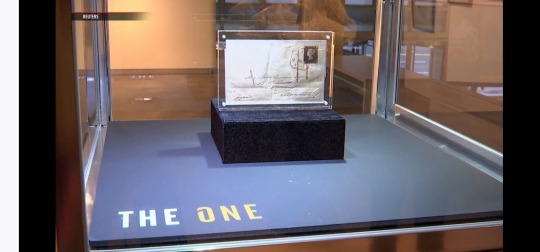
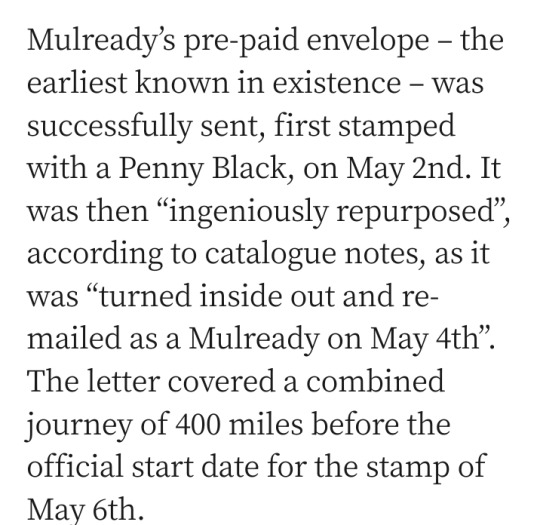
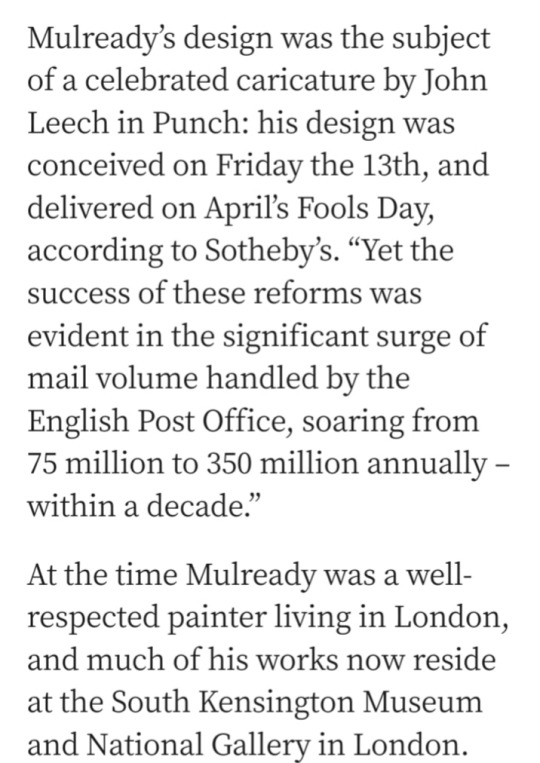
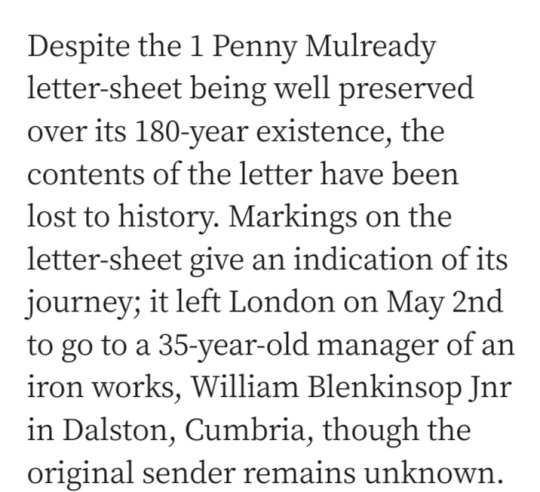

Source: Irishtimes
youtube
First piece of mail sent with postage stamp could fetch up to $2.5M at auction | ABS-CBN News
29 January 2024
The first known piece of mail sent using a postage stamp is about to hit the auction block at Sotheby's New York and could fetch up to $2.5 million.
— Report from Reuters
#Penny red stamp#Penny Black#posted envelope#prepaid stamp#William Mulready#Postage Reform Act of 1839#Mulready stationery#letters#postage stamps#John Leech#Ireland#Sotheby's New York#Youtube
0 notes
Text
In a world of emails, text messages, and instantaneous communication, old-fashioned postage stamps have largely been relegated to the back of envelopes. Yet for many it is the stamp alone that holds pride of place for conveying emotion and sentiment to recipients of postcards, parcels, and packages.
The stamp, though unseemly and often overlooked, is a potent symbol of the archival power of the written word and the serious responsibility an author has in giving her words a life beyond an often short-lived digital record.
The archival power of the stamp makes it more than just a postage tool. To be designated as worthy of an archival value, an item must be “enduring”. Lasting beyond a few weeks or months — and, at times, even surviving decades — stamps are used to signify important moments in our lives and are instrumental in preserving family memories.
Indeed, stamps have been a fixture of the archivist’s job for centuries. The British Royal Archives contain a vast array of letters and documents, each recorded with the stamp with which it was sent. The archive contains a wide variety of stamps, from the United Kingdom’s iconic Penny Black to stamps from a bygone era. The U.S. Library of Congress also preserves myriad stamps, such as those of the world’s first foreign post — the postmark of Constantinople in 1290; the Thurn and Taxis post of 1704; and the United States’ own post, established in 1775.
For all their ability to transport us to a moment in time, a stamp can also be a reminder of people, places, and moments that have passed away. They can evoke emotions of fear, sadness, joy, nostalgia, or just a fading memory. With the right stamp, a seemingly ordinary postcard or letter can become an irreplaceable piece of family history.
Ultimately, stamps are an often overlooked but compelling part of archival records. They are an important touchstone to the past and a powerful way of preserving pieces of our shared history.
0 notes
Text
Exploring the Rich Tapestry of History: The National Philatelic Museum in Delhi
In the bustling heart of India's capital, amidst the grandeur of New Delhi's historic landmarks, lies a hidden gem that takes visitors on a journey through time using miniature canvases of history. The National Philatelic Museum, nestled within the vibrant fabric of Delhi, offers an enchanting exploration of the world through postage stamps. This unique museum is a captivating testament to the art, culture, and history of philately, beckoning enthusiasts and curious minds alike.
A Glimpse into History
The National Philatelic Museum, managed by India Post, is a treasure trove of knowledge and nostalgia. Housed in a colonial-era building that exudes timeless charm, the museum welcomes visitors to a bygone era when written letters and postcards were the lifeblood of communication.
The World of Philately Unveiled
Philately, the art of collecting and studying postage stamps, finds its haven in this museum. It caters to both neophytes and connoisseurs, providing a comprehensive view of the evolution of postage stamps and their profound impact on preserving history.
The museum's collection spans centuries, boasting a remarkable assembly of rare and valuable stamps that narrate tales of nations, leaders, and pivotal events. From the world's first adhesive postage stamp, the "Penny Black" of Great Britain, to India's iconic "Scinde Dawk" stamps, each exhibit serves as a gateway to the past.
Stamps as Windows to History
Stamps, despite their diminutive size, are windows to the past. The National Philatelic Museum showcases stamps as historical artifacts that encapsulate the essence of their times. Visitors can marvel at stamps commemorating renowned personalities like Mahatma Gandhi, delve into India's arduous struggle for independence, and gain profound insights into the nation's rich cultural tapestry. Furthermore, the museum houses an extensive collection of international stamps, inviting visitors on a global odyssey through philately.
Educational Initiatives
The National Philatelic Museum isn't merely a place for passive observation; it actively promotes philately as a hobby and an educational tool. It hosts a plethora of workshops, seminars, and philatelic exhibitions that engage people of all ages. These initiatives not only nurture an appreciation for stamp collecting but also serve as a unique educational resource, shedding light on history, geography, and culture through the lens of stamps.
Interactive Exhibits
Visitors to the National Philatelic Museum can expect interactive exhibits that breathe life into the world of philately. Hands-on displays, informative placards, and multimedia presentations enhance the experience, making it both educational and entertaining.
The Museum's Role in Preserving Heritage
The National Philatelic Museum plays a pivotal role in preserving India's postal heritage. It safeguards valuable philatelic treasures and ensures that future generations can continue to explore the rich history encapsulated in stamps.
Conclusion
The National Philatelic Museum in Delhi is a captivating testament to the power of postage stamps as storytellers of history. It offers visitors a unique opportunity to delve into the past, celebrating the artistry, culture, and significance of these tiny yet powerful symbols. Whether you're a philatelist, a history enthusiast, or simply curious about the world, this museum in the heart of Delhi is a must-visit destination that will leave you with a deeper appreciation for the fascinating world of philately.
0 notes
Photo

The Penny Black. The worlds 1st adhesive postage stamp.
https://www.postalmuseum.si.edu/
https://postalmuseum.si.edu/exhibition/the-queen%E2%80%99s-own-postal-reforms-that-transformed-the-mail-the-worlds-first-postage-stamps
https://en.wikipedia.org/wiki/Penny_Black
#Washington D.C.#Washington#DC#D.C.#Smithsonian National Postal Museum#Smithsonian#National Postal Museum#Postal Museum#Museum#Penny Black#Philately#My Photography#Photographers on Tumblr
1 note
·
View note
Photo


While it may be National U.S. Postage Stamp Day, we want to pay homage to the Penny Black as it was the world’s first adhesive postage stamp and we have one in our collection!
34 notes
·
View notes
Photo

https://dharaastamps.co.in/shop/postage-stamps/worldwide-stamps/#worldwide-fdc-covers-worldwide-stamps/#world-#first#-#postage#-#stamps#-on-#cover#-#black#-#penny#-#1840#-dated-7th-nov-used-rare-2/ https://www.instagram.com/p/CWFfPAdvSIj/?utm_medium=tumblr
0 notes
Photo

Victorian Christmas Cards
Printed Christmas cards became popular in the Victorian period (1837-1901) thanks to a combination of cheaper printing techniques and even cheaper post, with the arrival of the Penny Black postage stamp. Coming in all shapes, sizes, and materials, Christmas cards were sent in their millions to all corners of the British Empire. Victorian illustrators created an entire mythology of exactly what we imagine a European Christmas should look like with their now-classic scenes of present-covered Christmas trees, holly, robins, sleighs, and snow-covered country lanes. When we dream of a white Christmas, it is the festive cards of the 19th century which are largely responsible for that evergreen imagery.
19th-Century Christmas Card
Victoria and Albert Museum, London (See Original Source)
Continue reading...
29 notes
·
View notes
Text
Events 5.1 (before 1950)
305 – Diocletian and Maximian retire from the office of Roman emperor. 880 – The Nea Ekklesia is inaugurated in Constantinople, setting the model for all later cross-in-square Orthodox churches. 1169 – Norman mercenaries land at Bannow Bay in Leinster, marking the beginning of the Norman invasion of Ireland. 1328 – Wars of Scottish Independence end: By the Treaty of Edinburgh–Northampton, England recognises Scotland as an independent state. 1486 – Christopher Columbus presents his plans discovering a western route to the Indies to the Spanish Queen Isabella I of Castile. 1707 – The Act of Union joining England and Scotland to form the Kingdom of Great Britain takes effect. 1753 – Publication of Species Plantarum by Linnaeus, and the formal start date of plant taxonomy adopted by the International Code of Botanical Nomenclature. 1807 – The Slave Trade Act 1807 takes effect, abolishing the slave trade within the British Empire. 1820 – Execution of the Cato Street Conspirators, who plotted to kill the British Cabinet and Prime Minister Lord Liverpool. 1840 – The Penny Black, the first official adhesive postage stamp, is issued in the United Kingdom. 1844 – Hong Kong Police Force, the world's second modern police force and Asia's first, is established. 1846 – The few remaining Mormons left in Nauvoo, Illinois, formally dedicate the Nauvoo Temple. 1851 – Queen Victoria opens The Great Exhibition at The Crystal Palace in London. 1863 – American Civil War: The Battle of Chancellorsville begins. 1865 – The Empire of Brazil, Argentina, and Uruguay sign the Treaty of the Triple Alliance. 1866 – The Memphis Race Riots begin. In three days time, 46 blacks and two whites were killed. Reports of the atrocities influenced passage of the Fourteenth Amendment to the United States Constitution. 1885 – The original Chicago Board of Trade Building opens for business. 1886 – Rallies are held throughout the United States demanding the eight-hour work day, culminating in the Haymarket affair in Chicago, in commemoration of which May 1 is celebrated as International Workers' Day in many countries. 1894 – Coxey's Army, the first significant American protest march, arrives in Washington, D.C. 1896 – Naser al-Din, Shah of Iran, is assassinated in Shah Abdol-Azim Shrine by Mirza Reza Kermani, a follower of Jamal al-Din al-Afghani. 1898 – Spanish–American War: Battle of Manila Bay: The Asiatic Squadron of the United States Navy destroys the Pacific Squadron of the Spanish Navy after a seven-hour battle. Spain loses all seven of its ships, and 381 Spanish sailors die. There are no American vessel losses or combat deaths. 1900 – The Scofield Mine disaster kills over 200 men in Scofield, Utah in what is to date the fifth-worst mining accident in United States history. 1915 – The RMS Lusitania departs from New York City on her 202nd, and final, crossing of the North Atlantic. Six days later, the ship is torpedoed off the coast of Ireland with the loss of 1,198 lives. 1919 – German troops enter Munich to suppress the Bavarian Soviet Republic. 1921 – The Jaffa riots commence. 1925 – The All-China Federation of Trade Unions is officially founded. Today it is the largest trade union in the world, with 134 million members. 1929 – The 7.2 Mw Kopet Dag earthquake shakes the Iran–Turkmenistan border region with a maximum Mercalli intensity of IX (Violent), killing up to 3,800 and injuring 1,121. 1930 – "Pluto" is officially proposed for the name of the newly discovered dwarf planet by Vesto Slipher in the Lowell Observatory Observation Circular. The name quickly catches on. 1931 – The Empire State Building is dedicated in New York City. 1945 – World War II: Up to 2,500 people die in a mass suicide in Demmin following the advance of the Red Army. 1946 – Start of three-year Pilbara strike of Indigenous Australians.
0 notes